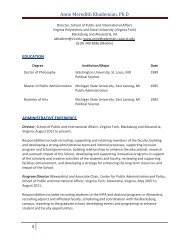Evaluating an interdisciplinary undergraduate training program in ...
Evaluating an interdisciplinary undergraduate training program in ...
Evaluating an interdisciplinary undergraduate training program in ...
Create successful ePaper yourself
Turn your PDF publications into a flip-book with our unique Google optimized e-Paper software.
Author's personal copy<br />
Table 2. Bivariate correlations of key study measures<br />
Measure BCCAI IPI TPPS LIS SCS IDSAI<br />
BCCAI 1 0.048 0.585** 0.008 0.324** 0.384**<br />
IPI 0.048 1 0.218* 0.007 0.312** 0.493**<br />
TPPS 0.585** 0.218* 1 0.306* 0.404** 0.645**<br />
LIS 0.008 0.007 0.306* 1 0.690** 0.071<br />
SCS 0.324** 0.312** 0.404** 0.690** 1 0.200*<br />
IDSAI 0.384** 0.493** 0.645** 0.071 0.200* 1<br />
*p0.05; **p0.01<br />
BCCAI, behavior ch<strong>an</strong>ge collaborative activities <strong>in</strong>dex; IDSAI, <strong><strong>in</strong>terdiscipl<strong>in</strong>ary</strong> scientific appreciation <strong>in</strong>dex; IPI, <strong><strong>in</strong>terdiscipl<strong>in</strong>ary</strong> perspectives<br />
<strong>in</strong>dex; LIS, laboratory impressions scale; SCS, social climate scale; TPPS, team project participation scale<br />
completed the BCCAI <strong>an</strong>d the IPI at Time 2. Rat<strong>in</strong>g of team<br />
projects occurred at the end of the <strong>program</strong> for each cohort.<br />
Interviews, however, were conducted only dur<strong>in</strong>g summer<br />
2006 us<strong>in</strong>g Cohort 2 of the ID-SURE <strong>program</strong>.<br />
Analysis Pl<strong>an</strong><br />
Prior to conduct<strong>in</strong>g the ma<strong>in</strong> data <strong>an</strong>alyses <strong>in</strong> 2007, statistical<br />
assumptions of power, homogeneity of vari<strong>an</strong>ce, <strong>an</strong>d homogeneity<br />
of regression were assessed. c No signific<strong>an</strong>t departures<br />
from these statistical assumptions were observed. Bivariate<br />
correlations, repeated measures ANOVA, <strong>an</strong>d l<strong>in</strong>ear<br />
regression <strong>an</strong>alysis were pl<strong>an</strong>ned for this study.<br />
Results<br />
c Variables <strong>an</strong>d covariates were checked for homoskedasticity <strong>in</strong> terms<br />
of homogeneity of vari<strong>an</strong>ce <strong>an</strong>d homogeneity of covari<strong>an</strong>ce. Homogeneity<br />
of regression was exam<strong>in</strong>ed by evaluat<strong>in</strong>g whether with<strong>in</strong>group<br />
regression coefficients for <strong>an</strong>y covariates were equivalent. For<br />
example, l<strong>in</strong>ear relationships with<strong>in</strong> <strong>an</strong>d across groups were evaluated<br />
for correlations among st<strong>an</strong>dardized residuals for vari<strong>an</strong>ce<br />
<strong>in</strong>flation factor <strong>an</strong>d tests of correlations between errors (e.g.<br />
Durb<strong>in</strong>Watson tests). Values miss<strong>in</strong>g at r<strong>an</strong>dom were replaced<br />
us<strong>in</strong>g a regression, l<strong>in</strong>ear-trend-at-po<strong>in</strong>t estimate. 17 Screen<strong>in</strong>g for<br />
outliers was achieved us<strong>in</strong>g diagnostic procedures available <strong>in</strong> statistical<br />
packages such as SPSS. Listwise outlier values were W<strong>in</strong>dsorized<br />
18 to preserve data. For all regression tests <strong>in</strong>clud<strong>in</strong>g those of<br />
moderators, centered variables were computed for variables <strong>in</strong> the<br />
regression equations <strong>an</strong>d other statistical models.<br />
One of the study goals <strong>in</strong>cluded measur<strong>in</strong>g <strong><strong>in</strong>terdiscipl<strong>in</strong>ary</strong><br />
processes <strong>an</strong>d products result<strong>in</strong>g from the <strong><strong>in</strong>terdiscipl<strong>in</strong>ary</strong><br />
<strong>tra<strong>in</strong><strong>in</strong>g</strong> <strong>program</strong>. Correlations between<br />
the process measures (described more fully <strong>in</strong> the<br />
Methods section) appear <strong>in</strong> Table 2. Note the signific<strong>an</strong>t<br />
positive correlations between the f<strong>in</strong>al project, as<br />
measured by the TPPS, <strong>an</strong>d two other measures: the<br />
IDSAI (r0.645, p0.001) <strong>an</strong>d the BCCAI (r0.585,<br />
p0.001).<br />
The follow<strong>in</strong>g results correspond to the hypotheses<br />
stated above. The first <strong>an</strong>d second hypotheses considered<br />
how the <strong>program</strong> curriculum <strong>in</strong>fluenced behaviors<br />
<strong>an</strong>d attitudes <strong>in</strong> the fellows. Hypothesis 1 was that<br />
the <strong>tra<strong>in</strong><strong>in</strong>g</strong> <strong>in</strong>creased the prevalence of tr<strong>an</strong>sdiscipl<strong>in</strong>ary<br />
behaviors, as <strong>in</strong>dicated by the BCCAI. A repeated<br />
measures ANOVA showed a highly signific<strong>an</strong>t<br />
ma<strong>in</strong> effect for time, F(1,61)27.15, p0.001 <strong>in</strong> the<br />
expected direction. Hypothesis 2 was that the <strong>tra<strong>in</strong><strong>in</strong>g</strong><br />
<strong>in</strong>creased the prevalence of tr<strong>an</strong>sdiscipl<strong>in</strong>ary perspectives,<br />
as <strong>in</strong>dicated by the IPI. A repeated measures<br />
ANOVA showed a highly signific<strong>an</strong>t ma<strong>in</strong> effect for<br />
time, F(1,82)5.26, p0.05, also <strong>in</strong> the expected<br />
direction.<br />
In addition to ch<strong>an</strong>ges <strong>in</strong> behaviors <strong>an</strong>d attitudes,<br />
Hypothesis 3 was that the ID-SURE curriculum, moderated<br />
by the faculty mentor’s research orientation, was<br />
associated with greater <strong>in</strong>tegrative quality of their products,<br />
such as their f<strong>in</strong>al summer research projects.<br />
Ch<strong>an</strong>ges <strong>in</strong> attitudes due to the ID-SURE curriculum, as<br />
measured by the IPI, showed the <strong>program</strong>’s <strong>in</strong>fluence<br />
on f<strong>in</strong>al projects. For example, us<strong>in</strong>g the IPI to predict<br />
f<strong>in</strong>al project quality, the regression model fit was modest<br />
but signific<strong>an</strong>t, adjusted R 2 0.038, F(1,81)4.16,<br />
p0.05.<br />
Additionally, the IPI as well as the BCCAI were used<br />
to measure the <strong>in</strong>fluence of mentors on fellow <strong><strong>in</strong>terdiscipl<strong>in</strong>ary</strong><br />
behaviors <strong>an</strong>d perspectives. Ch<strong>an</strong>ges <strong>in</strong> attitude<br />
due to the mentor’s <strong>in</strong>fluence, as measured by the<br />
mentors’ BCCAI or IPI scores, also showed <strong>an</strong> <strong>in</strong>fluence<br />
on behaviors <strong>an</strong>d attitudes. Us<strong>in</strong>g mentors’ scores at<br />
Time 1 to predict the BCCAI or IPI scores of fellows at<br />
Time 3, the regression model fits were signific<strong>an</strong>t:<br />
BCCAI, adjusted R 2 0.499, F(1,70)71.77, p0.001;<br />
IPI, adjusted R 2 0.129, F(1,92)14.42, p0.001,<br />
respectively.<br />
Hypothesis 4 was that ID-SURE fellows would display<br />
greater shifts toward tr<strong>an</strong>sdiscipl<strong>in</strong>ary activities <strong>an</strong>d<br />
values <strong>an</strong>d achieve higher levels of <strong>in</strong>tegrative quality<br />
<strong>in</strong> their research products (f<strong>in</strong>al summer research<br />
projects) compared to those students <strong>in</strong> the fellowship<br />
<strong>program</strong>s who were not exposed to the <strong><strong>in</strong>terdiscipl<strong>in</strong>ary</strong><br />
<strong>tra<strong>in</strong><strong>in</strong>g</strong> curriculum. A 10-po<strong>in</strong>t scale was used for<br />
judg<strong>in</strong>g the <strong>in</strong>tegrative quality of the f<strong>in</strong>al summer<br />
research projects. d<br />
Between-groups <strong>an</strong>alyses compar<strong>in</strong>g ID-SURE fellows<br />
<strong>an</strong>d nonfellows found no signific<strong>an</strong>t differences between<br />
either the <strong>in</strong>tegrative quality of the f<strong>in</strong>al projects<br />
or the IPI. Interdiscipl<strong>in</strong>ary behaviors, on the other<br />
d No signific<strong>an</strong>t differences were expected or found <strong>in</strong> the <strong>in</strong>tellectual<br />
quality of the projects, among the two comparison groups. S<strong>in</strong>ce<br />
fellows <strong>in</strong> both groups were recruited based on their GPAs <strong>an</strong>d the<br />
quality of their proposals, it was expected that students <strong>in</strong> both<br />
groups would have achieved high levels of academic <strong>an</strong>d <strong>in</strong>tellectual<br />
achievement.<br />
April 2009 Am J Prev Med 2009;36(4) 363





